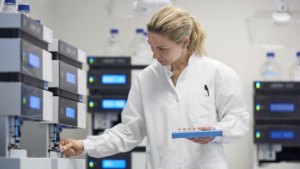
Do you really know what is in your vaccine?
CAD is a universal detector able to detect all non-volatile, and many semi-volatile analytes. This uniform response enables accurate quantitation of most excipients in a vaccine formulation.
Liquid chromatography is ideal for analyzing and assessing the stability of complex mixtures like vaccine formulations made from a diverse pool of ingredients.
As with any pharmaceutical, robust analytical methods to characterize the quality and stability of vaccine formulas are critical to patient safety and approval by regulatory bodies.
While conventional analytical HPLC-UV or LC-MS methods are a standard part of vaccine development, these techniques fall short when the supporting additives lack a chromophore or may not form gas-phase ions.
For situations where analytes in a sample are incompatible with UV and MS detectors, scientists turn to an advanced LC detection approach called charged aerosol detection (CAD) to get an in-depth look at both the composition and stability of vaccines.
Charged aerosol detection is a must-have analytical tool critical to the development process and monitoring quality control in large-scale manufacturing. This cutting-edge technology enables the in-depth characterization of vaccine composition, stability, and identification of impurities and degradation products.
The best part is you do not have to choose one detection over another. You can use CAD to complement your HPLC-UV analysis in a situation where excipients in a formula are a mix of UV active and inactive components. Using these tools together gives you a robust and reliable analytical detection method to determine the stability of all vaccine excipients.
The major benefits of using CAD technology to analyze vaccine excipients are:
2. Sensitive detection independent of whether a chromophore is present or not (unlike UV) or whether the compound forms gas-phase ions (unlike MS).
3. Uniform response, as in the ability to obtain the same response for all components regardless of the analyte structure.
4. Standard-free quantitation. You don’t need a standard to?quantify an unknown. This is important when reference standards are unavailable for impurities and degradants.
For a more detailed look at why vaccine developers need CAD, read this blog.


 BIOCOM / aminul788 - Adobe Stock
BIOCOM / aminul788 - Adobe Stock Bayer Co.Lab
Bayer Co.Lab